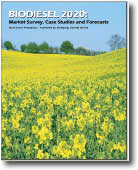 The second edition of Biodiesel 2020: A Global Market Survey has come out, filled with information on which direction the biodiesel industry is headed.
The second edition of Biodiesel 2020: A Global Market Survey has come out, filled with information on which direction the biodiesel industry is headed.
This story posted on EarthTimes.org says the biodiesel industry is entering four fundamental transitions: moving from edible feedstocks (soy and palm oils) to non-food feedstocks; moving from production in developed countries’ commercial markets to emerging markets in developing nations; moving up to 2nd generation technologies; and moving into government policies favoring sustainable fuels:
“Biodiesel markets world-wide are entering a period of rapid transitional growth, creating both uncertainty and opportunity. First generation biodiesel markets in Europe and the US have reached impressive biodiesel production capacity levels, but remain constrained by feedstock availability. In the BRIC nations of Brazil, India and China, recent government initiatives are spawning hundreds of new opportunities for feedstock development, biodiesel production, and export,” said Biodiesel 2020 author Will Thurmond.
“Biodiesel 2020 observes a fundamental transition in global transport fuels production. In the year 2007, there were only 20 oil producing nations supplying the needs of over 200 nations. By the year 2010, more than 200 nations will become biodiesel producing nations and suppliers,” said Thurmond.
The report concludes with some solid advice for biodiesel producers:
“Transitions in the biodiesel industry will create winners and losers in the near term. The Biodiesel 2020 study concludes biodiesel producers that are best able to adapt to transitions in feedstocks, government policies, markets, and technologies are most likely to succeed over the long term.”

